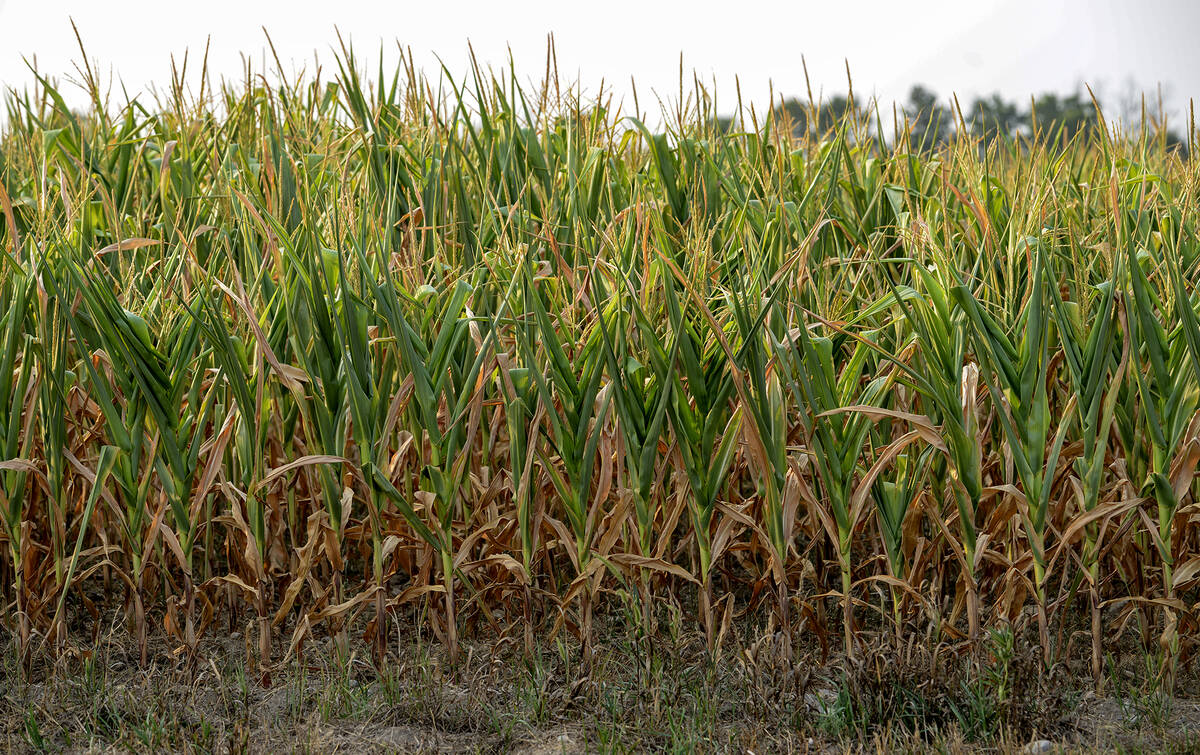The Ontario growing region received average precipitation in July, and temperatures were two to three degrees below normal. Most farmers in Ontario are expecting above average yields for corn and soybeans. The winter wheat harvest is complete. There are no quality problems and yields are slightly above the five-year average.
We’re expecting significant harvest pressure over the next month. Ontario farmers sell the bulk of their crops in the first five months of the crop year. We’ve advised producers to be 20 per cent sold on corn and soybeans and 10 per cent sold on wheat. In our previous article, we stressed the importance of selling regular increments throughout the crop year.
Quick look
Soybeans: U.S. and Chinese relations are the ‘wild card’ for forecasting price.
Corn: Good yields and extra acreage should make Ontario’s corn crop a bin buster.
Wheat: Although overall tonnage in the province is down from 2021, nearly all winter wheat is milling quality.
Read Also

Extreme variability marks Ontario’s 2025 corn crop
The yield potential of Ontario’s 2025 corn crop was lost in some areas due to extreme dry conditions.
Trend yields are expected for U.S. corn and soybean crops. Past weather and the current forecasts are optimal for crop development. When there are no major weather concerns, yields are usually better than anticipated.
As of Aug. 7, the Argentine corn harvest was 85 per cent complete while Brazilian farmers had harvested approximately 75 per cent of the Safrinha corn crop. The European corn crop has experienced yield drag due to extreme heat but Europe is not a major corn exporter. Europe is a minor producer for soybeans and import demand is the same every year.
The U.S. and European winter wheat harvests are complete. The Russian winter wheat harvest was just over 60 per cent complete as of Aug. 8. Adverse rains have hindered quality and protein projections but yields reports confirm the year-over-year increase in production. The Russian spring wheat crop is in good shape with average protein expected.
Outside influences are somewhat bearish for the grain and oilseed markets. U.S. relations with China could alter soybean and corn trade flows during the 2022-23 crop year. October crude oil has been actively trading below $90/barrel, prices not seen since the unprovoked Russian invasion of Ukraine. Factors driving food inflation are easing due to weaker energy prices. The price for a loaf of whole wheat bread from my local Wal-Mart was $1.68 last week and the quality was excellent. Is the media still hyping up a global food shortage?
On a side note, beef prices are set to make fresh historical highs over the winter. Cattle will be the last commodity to rally after COVID in case one missed the opportunity in crude oil, copper, metals, grains, oilseeds or lumber.
Soybeans
Ontario soybean production is expected to reach 4.2 million tonnes, up from the year-ago output of 4.1 million tonnes and up from the five-year average of 3.9 million tonnes. Ontario farmers delivered 2.8 million tonnes from Aug. 1, 2021 through Dec. 31, 2021, which would be about 70 per cent of the crop. During the 2021-22 crop year, Ontario soybean prices made seasonal lows during the first half of October around $14.50/bu. We’re expecting a similar price pattern as last year. Ontario soybean prices are expected to make seasonal lows in October and then rally into January.
The U.S. is in the midst of a trade war and tech war with China. A cold war has now developed between the two superpowers over Taiwan. The west is also critical about human rights abuses, not to mention hangover blame on China for COVID.
Polls show that approximately 80 per cent of Americans have an unfavourable view of China so it’s a political rallying point. U.S. and Chinese relations are a key influence on the soybean market. This is the “wild card” that makes price forecasting difficult.
At the time of writing this article, soybeans out of the U.S., Brazil and Argentina were all equally priced on a f.o.b. basis. The downside is limited on soybean futures in the short term although we expect basis deterioration in Ontario through September and the first half October.
U.S. soybean production is estimated at 122 million tonnes, up one million tonnes from last year. U.S. ending stocks for the 2022-23 crop year are expected to finish near six million tonnes, unchanged from the 2021-22 carryout. Brazil and Argentina are the residual carriers for world soybeans as each country will carryout about 20 million tonnes this year. Next winter, Brazilian soybean production is expected to come in at 149 million tonnes, up from the 2021-22 output of 126 million tonnes. Argentine output is expected to reach 51 million tonnes, up eight million tonnes from the 2021-22 crop.
The ending stocks in Argentina will build by six million tonnes and finish near 25 million tonnes. Brazilian stocks will swell by 10 million tonnes reaching more than 30 million tonnes. South American countries can open the tap. They could satisfy the bulk of Chinese demand and leave the U.S with a surge in carryout similar to 2018-19.
What to do: We’ve advised producers to be 20 per cent sold on their 2022 production. Our plan is to limit sales in September and October and step-up incremental recommendations from November through January. The 2022-23 crop year for the soybean market will be defined by record South American production and rising U.S.-Chinese tensions.
Corn
Ontario corn production is expected to reach 9.9 million tonnes this year, up from the 2021 crop size of 9.5 million tonnes and up from the five-year average of 8.9 million tonnes. The Ontario corn crop will be a bin-buster.
Domestic feed demand is at seasonal lows in September. Exports only increase in late October or November. During the 2021-22 crop year, Ontario farmers sold about 60 per cent of their production in the first five months of the crop year.
France and Romania are the main corn producers in Europe. Each country produces about 14 million tonnes, followed by Hungary, which produces about eight million tonnes and then Poland where the output is about seven million tonnes. Europe has been plagued by extensive heat throughout July. France received average precipitation in July but Romania, Hungary and southern Poland received less than 50 per cent of normal precipitation.
At the time of writing this article, corn prices f.o.b. the Gulf were US$300/tonne while Brazilian corn was offered at $290/tonne. French corn was priced at $350/tonne f.o.b. La Pallice. Ontario corn was priced at $285/tonne f.o.b. St. Lawrence port.
We’re expecting a sharp year-over-year increase in Ontario corn exports to Northern Europe. Usually, the domestic feed market is premium to export values in southern Ontario but we may see an altered price structure during the first half of the crop year. We expect elevator bids for offshore movement will be premium to domestic feedlots this fall.
Make sure you shop around when selling corn because there will be a wide variation in bids depending on the company’s destination or sales program.
The Ukraine has exported about 200,000 tonnes of corn over the past couple weeks, according to trade estimates. This has put a bearish spin on the corn market but we wouldn’t make too much of this news. More importantly, the managed money or large speculator has become a main buyer of the corn futures in early August. On March 22, the managed money had a net long of 246,700 contracts. This position dipped to a low of 111,784 contracts on July 26. On Aug. 2, the managed money position was 118,034. It appears the sentiment from the managed money has changed.
For corn, it’s important to be an incremental seller throughout the crop year because the market makes seasonal highs in November and then again in April. Last year, Ontario elevator bids made seasonal lows in October around $6.30/bu. and then reached up to $7.30/bu. by the end of December. We’re expecting a similar price pattern this year.
The rally may be more defined due to a year-over-year increase in European demand. The market will make another seasonal high in March 2023 because the bulk of new crop South American supplies are only available in May.
What to do: We’ve advised producers to be 20 per cent sold on their 2022 production. We’re planning to make our next sale in late October or November.
Wheat
We’re forecasting Ontario winter wheat production to finish near two million tonnes, down from the 2021 winter wheat output of 2.7 million tonnes. We’re not hearing of any major quality issues this year, which will limit supplies trading into feed channels. Nearly all of the Ontario wheat crop is milling quality. Last year, Ontario elevator bids for soft red winter wheat made a seasonal low in mid-September around $7.80/bu. and then rallied to $9.50/bu. in mid-November.
Ontario farmers sold approximately 85 per cent of their wheat in the first five months of the crop year. In normal years, the wheat market has two defined seasonal highs. The first is in November and the second in March as the Northern Hemisphere crop comes out of dormancy.
European winter wheat production is forecasted to finish near 126 million tonnes, down from 131 million tonnes last year. There was some yield drag in Central Europe due to the heat. Traders are comfortable with the USDA hard red winter wheat production estimate of 15.9 million tonnes, down from the 2021 output of 20.4 million tonnes. U.S. soft red winter production is expected to finish near 10.2 million tonnes, up from the year-ago crop size of 9.8 million tonnes.
Russian wheat production is expected to reach 95 million tonnes. This is up from previous estimates near 90 million tonnes and up from the year-ago output of 75 million tonnes. News reports suggest that Russia has increased its export tax from $75/tonne to $86/tonne. There are sanctions in place but it’s hard to forecast how these sanctions will play out in the wheat trade. There appears to be some leniency when it comes to food trade. Of course, it all depends on price in the long run.
French winter wheat was offered at $352/tonne f.o.b. Rouen, while U.S. No.2 hard red winter was quoted at $372/tonne f.o.b. the Gulf and soft red winter was offered at $331/tonne. Given freight spreads, the wheat is equally priced. Ontario soft red winter is quoted at $325/tonne f.o.b. the St. Lawrence. The wheat market is at seasonal lows.
What to do: We’ve advised Ontario farmers to be 10 per cent sold on their winter wheat. We’re planning to make our next sales recommendation in late October or early November.













